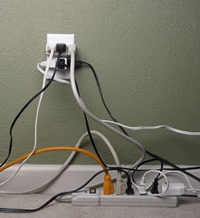
 Advanced Power Strips (APS)
Advanced Power Strips (APS)
Many electronic devices continue to use a small amount of electricity even when they are switched off. APS technology differs from standard power strips as it has the added ability to eliminate phantom and standby power loss from various electronic products. Reducing the standby power with APS devices would have an immediate effect on the large percentage of wasted energy. NEEP, in conjunction with leading industry stakeholders, have developed various resources and have made the following documents publicly available. NEEP continues to track APS activity in the region, best practices nationally, and maintain a regional dialogue – particularly regarding program design.
Case Study: Tier 2 Advanced Power Strips and Efficiency Programs
Tier 2 APS are activity monitoring power strips that manage both standby and active power consumption. They offer an additional level of savings to traditional or "Tier 1" APS by monitoring a user's engagement with their electronics or presence in a room. This APS Case Study will highlight a few examples of efficiency program success in integrating Tier 2 APS into their programs and touch on some of the research and analysis that exists on Tier 2 APS products to date.
Advanced Power Strips Testing Protocol
This document is part of NEEP’s overall effort to formulate a robust assessment methodology of APS and attain confidence in the energy savings potential of these devices. The sole purpose of the Advanced Power Strip Testing Protocol is to define a set of procedures that, when executed, provide quantitative data on the technical functionalities of each APS. The uniform metric applied to all test samples allows an objective comparison of each feature across all products.
Getting to Know Advanced Power Strips
There are several different types of APS on the market, but they all operate on the same basic principle of shutting off the supply power to devices that are not in use. By replacing your standard power strip with an APS, you can significantly cut the amount of electricity used by your devices and save money on your electric bill. The Getting to Know Advanced Power Strips document is intended to walk through several questions and misconceptions regarding APS.
Advanced Power Strip Terminology
Subcategories are used by manufacturers to describe their Advanced Power Strip and its associated control strategy in more detail. To increase consistency within the region, NEEP has assembled an Advanced Power Strip Terminology document for common and specific language. With better consistency in how we talk about APS makes it easier to understand the opportunity of these products.
NEEP APS Deemed Savings Methodology
In January 2012, the APS Working Group produced the NEEP APS Deemed Savings Methodology which illustrates the average annual energy and financial savings for a typical household. For a typical household, using one APS for entertainment purposes and one for home office purposes would result in an estimated savings for 106.1 kWh (75.1 kWh home entertainments and 31 kWh home office) per year.
OUTSIDE RESOURCES
National Renewable Energy Laboratory (NREL): NREL's buildings research teams lead efforts in developing cutting-edge technical solutions to improve the energy efficiency of both residential and commercial buildings. NREL has produced reports such as, Results of Laboratory Testing of Advanced Power Strips. In this report, 20 APS devices are subjected to a range of home entertainment center and home office usage scenarios to evaluate their technical performances. NREL also developed an educational APS Decision Tree which highlights that while there are many different types of APS on the market, they all operate on the same basic principle of shutting of supply power to devices that are not in use.
Additional resources:
- Department of Energy Better Building/NREL produced Guidance Document on Technical Specifications for Advanced Power Strips
- Department of Energy Better Building/NREL produced Fact Sheet for How to Use Advanced Power Strips in an Office Setting
- Department of Energy Better Building/NREL produced Fact Sheet on Plug Load Control: APSs Decrease Energy Consumption
- Department of Energy Better Building/NREL produced Guidance document, Myth Busting: Market Barriers to APS
- NREL blog post on Tier 1 vs Tier 2 APSs
- An IMT/DCSEU Tower Companies Plug Load Study
- A Seventhwave Commercial APS study
- A Johnson Consulting Group Meta Study on Tier 2 APS
- Energy Trust of Oregon Pilot Study of Tier 1 APS in Multifamily
